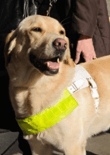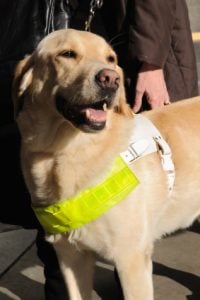The Benefits of Therapy Dog Training.
By Sally Gutteridge | Posts

 The Therapy dog is a concept that has changed the lives of countless people.
The Therapy dog is a concept that has changed the lives of countless people.
Organized therapy dog training is common. Charities that provide trained dogs for recipients that live with disability are becoming established in many countries. Guide dogs for blind people are one of the earlier formed organizations but they are now closely followed by others: Hearing dogs, Seizure alert assistance dogs and the canine trained to help disabled people with physical tasks.
The dog is an amazing companion. Constantly loyal and steadfastly intelligent, it is not surprising that we have created a role for the canine by using therapy dog training.
The guide dog is trained to physically lead their human partner through everyday life. Hearing therapy dog training teaches the dog to alert his owner to everyday and important emergency sounds. The physically disabled recipient of a specifically trained dog benefits from help with various tasks including shopping and household chores. Pets as visiting therapists to both hospitals and residential homes are extremely popular. These canine visitors are often the highlight of an elderly or sick person’s week.
Lesser known therapy dog training
Most people when seeing a guide or hearing dog know the dog’s general position. They have an idea of what these dogs do and are not surprised to see them out with handlers in a working role. In the background behind the main types of therapy dog training there are many others doing an equally important job.
Dogs are trained to give prior warning of human seizures. They recognize the chemical imbalance in their handler on the build-up to a seizure and alert their human to prepare and get into a safe place.
Dogs are employed in partnerships with people that suffer from anxiety attacks and other psychological illness. The solid and dependable canine can provide a unique and safe relationship to a nervous or mentally traumatized person. Recent therapy dog training has included recipients suffering from Post-traumatic shock syndrome.
Dual purpose dogs are employed to become an invaluable partner to a deaf blind person. These dogs literally become someone’s eyes and ears.
Dogs are long known partners of children with autism. The wagging tail and gentle eyes of a dog can support a troubled child at exactly the point he needs it.
The partnership of strength and alliance between a therapy dog and his human is amazing.
Human and canine bond
Any dog owner will tell you that the relationship between their canine and themselves is unique. Often people state that their dog understands them and is always pleased to see them. The forgiving dog brightens their day. It seems that the benefits we receive from our pets are only the tip of a huge iceberg of service offered by the canine species.
Many dogs provide intensive support to their owners with no therapy dog training at all. Or well outside the level of their formal training. It is usual to hear from a dog owner that their pet helped them through difficult times. Dogs provide support as part of their nature and as human beings we channel such support into the role that is most useful to us.
Therapy dog training
Part of the beauty of therapy dog training is the need for reward based reinforcement. The specific role and need to be so close to a potentially vulnerable human being requires the best and highest quality dog training techniques.
A dog will not take the washing from the machine just because you tell it to. A dog is far more likely to do the job if there is a reward offered. The role of therapy dog must be taught and reinforced with kindness.
Therapy dog training is intensive and can be taxing on the dog, just as any intensive learning is challenging for a human being. Many functions must be taught in a set amount of time. Usually therapy dog training is personalized and the dog trained specifically to fit into the lifestyle that he will be joining. With personalization in mind the dog’s nature is also matched perfectly to his new home.
A therapy dog must be happy and continually rewarded for his service. It is the only way to get the best from him. Positive and reward based training will create and maintain a successful canine and human partnership.
Session expired
Please log in again. The login page will open in a new tab. After logging in you can close it and return to this page.